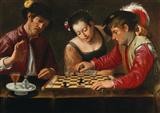Follower of Michelangelo Merisi, called Caravaggio, 17th Century
Chess players,
oil on canvas, 95 x 133.5 cm, framed
Provenance:
Hôtel Mazin Lafayette, Paris, since the 18th Century
The present painting relates to a composition conserved in the Galleria dell’Accademia, Venice, which is also by an unknown hand, which was formerly considered by Benedict Nicolson to be by an imitator of Bartolomeo Manfredi (see B. Nicolson, Caravaggism in Europe, second edition, revised and enlarged by Luisa Vertova, Turin 1990, vol. I, p. 146, no. 347 and vol. II, fig. 347). The present painting, representing chess players, belongs alongside a group of other works with scenes of gaming that were especially popular during the first half of the seventeenth century, in the wake of such innovative examples as Caravaggio’s Cardsharps (Kimbell Art Museum, Fort Worth) and the contributions Bartolomeo Manfredi made to the broad diffusion of such themes. These works, however, are rooted in a much older tradition, largely derived from Northern Europe, which thanks to the wide distribution of printed material saw such iconographic themes spread throughout the continent. Indeed, before the introduction of Caravaggio’s innovations, the theme of gaming had had exclusively moral overtones, as an admonishment against vice. From the Middle Ages, the Church had condemned games of chance, and especially those related to risk and luck, on account of the dangers of squandering money through gambling. However, different attitudes prevailed towards board games, which were tolerated because they were perceived as related to individual ability and reasoning. In particular, chess had been entirely accepted by court culture because it was believed to be free of any aspect of deception or fraud, and was therefore considered ‘gentile’ as confirmed by Baldassarre Castiglione in his Book of the Courtier. Writers and poets wrote compositions on the game: Marco Girolamo Vida gave his Scacchia Ludus at the beginning of the sixteenth century and Matteo Bandello wrote a sonnet (number 154 of his Rime) in which the game is interpreted as a metaphor for the game of love (on all these elements related to gaming see: P. Carofano (ed.), Il giuoco al tempo di Caravaggio, exhibition catalogue, Pontedera 2013). The Game of chess by Giulio Campi of Cremona (Museo Civico d’Arte Antica, Palazzo Madama, Turin) was also given such an allegorical meaning and Campi is one of the Lombard painters Caravaggio most likely studied before his departure for Rome. In seventeenth century representation of games, like the one under discussion here, the game no longer serves as an admonishment, rather it appears as the ‘expression of socio-dynamic interaction’ (see P. Carofano, Ibid., p. 13) and notably it exemplifies interaction between the classes.
View it on
Sale price
Estimate
Time, Location
Auction House
Chess players,
oil on canvas, 95 x 133.5 cm, framed
Provenance:
Hôtel Mazin Lafayette, Paris, since the 18th Century
The present painting relates to a composition conserved in the Galleria dell’Accademia, Venice, which is also by an unknown hand, which was formerly considered by Benedict Nicolson to be by an imitator of Bartolomeo Manfredi (see B. Nicolson, Caravaggism in Europe, second edition, revised and enlarged by Luisa Vertova, Turin 1990, vol. I, p. 146, no. 347 and vol. II, fig. 347). The present painting, representing chess players, belongs alongside a group of other works with scenes of gaming that were especially popular during the first half of the seventeenth century, in the wake of such innovative examples as Caravaggio’s Cardsharps (Kimbell Art Museum, Fort Worth) and the contributions Bartolomeo Manfredi made to the broad diffusion of such themes. These works, however, are rooted in a much older tradition, largely derived from Northern Europe, which thanks to the wide distribution of printed material saw such iconographic themes spread throughout the continent. Indeed, before the introduction of Caravaggio’s innovations, the theme of gaming had had exclusively moral overtones, as an admonishment against vice. From the Middle Ages, the Church had condemned games of chance, and especially those related to risk and luck, on account of the dangers of squandering money through gambling. However, different attitudes prevailed towards board games, which were tolerated because they were perceived as related to individual ability and reasoning. In particular, chess had been entirely accepted by court culture because it was believed to be free of any aspect of deception or fraud, and was therefore considered ‘gentile’ as confirmed by Baldassarre Castiglione in his Book of the Courtier. Writers and poets wrote compositions on the game: Marco Girolamo Vida gave his Scacchia Ludus at the beginning of the sixteenth century and Matteo Bandello wrote a sonnet (number 154 of his Rime) in which the game is interpreted as a metaphor for the game of love (on all these elements related to gaming see: P. Carofano (ed.), Il giuoco al tempo di Caravaggio, exhibition catalogue, Pontedera 2013). The Game of chess by Giulio Campi of Cremona (Museo Civico d’Arte Antica, Palazzo Madama, Turin) was also given such an allegorical meaning and Campi is one of the Lombard painters Caravaggio most likely studied before his departure for Rome. In seventeenth century representation of games, like the one under discussion here, the game no longer serves as an admonishment, rather it appears as the ‘expression of socio-dynamic interaction’ (see P. Carofano, Ibid., p. 13) and notably it exemplifies interaction between the classes.



